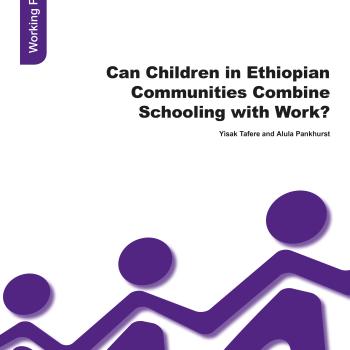
Combining school with work presents challenges for children growing up in contexts of poverty. Drawing on evidence from three rounds of surveys and three rounds of qualitative research with case study children, we examine the complex relationship between school and work in the lives of children in Ethiopian communities studied by Young Lives.
Analysis of Young Lives survey data showed that a third of the children were not in school at the age of 8 (when they should have started when they were 7) and almost a third of the caregivers mentioned the need for children to work as the reason. Primary school completion rates were low, with less than a fifth of children having completed primary school (Grades 1–8) at the age of 15. Children across the board worked as well as going to school, irrespective of age, gender, location and wealth. However, girls spent slightly more time at school and boys somewhat more time studying out of school, and children from poorer backgrounds spent less time at school and more time doing all kinds of work than those from non-poor backgrounds. As children grew older they spent more time on work but the amount of time they spent in school and studying at home hardly changed.
In a context where opportunities for paid work have expanded, the underlying structural poverty, poor quality of the school system and limited chances to succeed through education have put a strain on children’s ability to combine work and school successfully. This resultant pressure tended to lead children, especially in households that had faced health and livelihood shocks, to miss classes and eventually give up and become engaged in full-time work.
The findings raise questions about the quality and value of education for children living in poor circumstances, the risks associated with the expansion of paid work and the constraints on children managing school and work. Potential policy implications include the need for social protection for children living in households facing shocks, the need for flexible learning opportunities for working children and ensuring that when children have to work they are not involved in the ‘worst forms’ of work, nor in excessive hours or hazardous working conditions.

Combining school with work presents challenges for children growing up in contexts of poverty. Drawing on evidence from three rounds of surveys and three rounds of qualitative research with case study children, we examine the complex relationship between school and work in the lives of children in Ethiopian communities studied by Young Lives.
Analysis of Young Lives survey data showed that a third of the children were not in school at the age of 8 (when they should have started when they were 7) and almost a third of the caregivers mentioned the need for children to work as the reason. Primary school completion rates were low, with less than a fifth of children having completed primary school (Grades 1–8) at the age of 15. Children across the board worked as well as going to school, irrespective of age, gender, location and wealth. However, girls spent slightly more time at school and boys somewhat more time studying out of school, and children from poorer backgrounds spent less time at school and more time doing all kinds of work than those from non-poor backgrounds. As children grew older they spent more time on work but the amount of time they spent in school and studying at home hardly changed.
In a context where opportunities for paid work have expanded, the underlying structural poverty, poor quality of the school system and limited chances to succeed through education have put a strain on children’s ability to combine work and school successfully. This resultant pressure tended to lead children, especially in households that had faced health and livelihood shocks, to miss classes and eventually give up and become engaged in full-time work.
The findings raise questions about the quality and value of education for children living in poor circumstances, the risks associated with the expansion of paid work and the constraints on children managing school and work. Potential policy implications include the need for social protection for children living in households facing shocks, the need for flexible learning opportunities for working children and ensuring that when children have to work they are not involved in the ‘worst forms’ of work, nor in excessive hours or hazardous working conditions.

